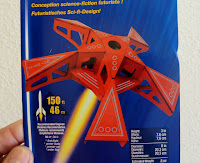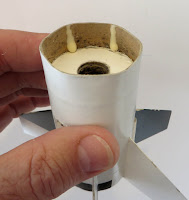My Alway Saturn IV sat in a tree for a month after a B6-4 flight last May.
At the June club launch I found it at the base of a tree. It was wet and the soaked body tubes were squishy.
CLICK HERE to see the story.
I let it dry out. While the tubes are showing their seams now, the model feels very strong. There are six BT-5 tubes at the bottom. The paint and vinyl Contact paper trim was clean. The home print decals were starting to release.
Well constructed and sealed models stay together longer. If this were a "naked" build, there wouldn't be anything left after the rain and sun exposure.
I finally got around to gluing it back together.

Lonnie B. knew I needed a new nosecone. The original nose cone and parachute were still high up in the tree.
Lonnie donated a Bullpup kit, the right nosecone is in the kit bag.
Problem was, the BT-55 body tube had shrunk!
I sanded the shoulder until I got a good slip fit. I was concerned, too much sanding and I would have gone through the plastic wall!

I never liked the shock cord attachment on this nose cone.
The plastic loop was cut off and the hole at the base was widened.
A shock cord was tied through the base and one of the loop holes.
I don't use masking tape to hold engine hooks on the engine mount tube. They do decompose over time.
The old engine mount tube was pulled out, the electrical tape had to be removed afterwards. The tape still looked new and the overlap was still strongly adhered.




















































